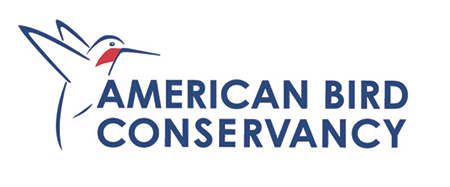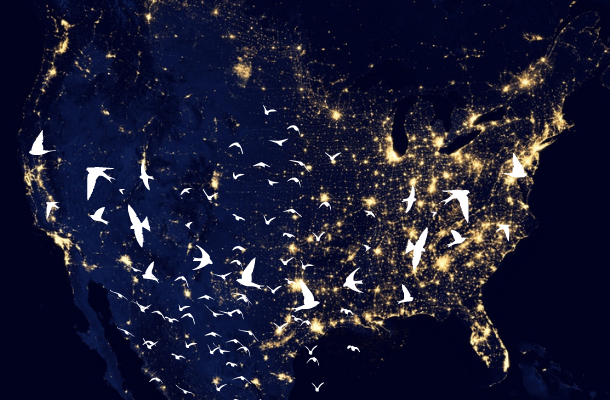| Misguiding Lights: American Bird Conservancy Highlights Artificial Light’s Link to Bird-Glass Collisions Understanding how human-generated light is linked to bird-collision deaths could help build effective policies that reduce these tandem threats across cities and regions |
 | Media Contact: Jordan Rutter, Director of Public Relations| jerutter@abcbirds.org | @JERutter |
(May 12, 2022) Spring migration is upon us, and billions of birds are navigating north under the night sky. Unfortunately, many won’t make it to their destinations. As highlighted by this year’s Migratory Bird Day theme of light pollution, millions of birds traveling over North America will become disoriented by artificial light and die after a collision with glass this season. To help equip the public and policymakers with the latest science-based recommendations to reduce light-related bird deaths, American Bird Conservancy (ABC) has released a position statement on this issue, entitled Misguiding Light: The Role Artificial Light Plays in Bird Mortality from Collisions with Glass. “There is more and more scientific evidence of the pervasiveness of light pollution and its negative impact on birds,” said Christine Sheppard, ABC’s Glass Collisions Program Director and author of the new position statement. “ABC has gathered this information, along with recommendations to help combat the problem and reduce bird mortality.” Artificial light at night disorients migrating birds like the White-throated Sparrow and the Hermit Thrush, luring them toward and into urban centers. Once birds land near buildings, they are at increased risk of glass collisions, one of the most significant human-caused threats to birds in North America. The dangers posed to birds by artificial light spread as expanding development illuminates more of the night sky each year. By taking actions to counteract light pollution, policymakers and the public can save many birds’ lives. Voluntarily darkening the night sky for birds — especially during migration — has gained traction since the first “Lights Out” efforts began in Chicago, Illinois, in 1995 and Toronto, Ontario, in 1997. Since then, dozens of cities in North America have adopted a Lights Out program, in which participating large buildings elect to turn off lights at night during migration seasons. These efforts are already helpful in reducing bird mortality around specific buildings, but legal requirements could make them even more effective and comprehensive. Regional- and national-level policies and ordinances can lead to more consistent and coordinated actions. “Lights Out programs do a lot to inform the public and to reduce light pollution, but we need to do much more if we are to reverse current trends,” Sheppard said. ABC recommends that more places in North America follow the lead of New York City and consider replacing or supplementing voluntary programs with policy solutions. Such solutions don’t have to be confined to simply turning out the lights during migration. Changing the way we use lights at night can also make a big difference for birds. “Smart” motion-sensing lights, for example, are a promising tool to cut down on bird collisions by automatically reducing light pollution. Also, studies have shown that turning off bright lights for short bursts when birds are circling overhead can “release” them back into the night. Another way to save birds is to permanently replace steady light sources with flashing or strobe lights. Thousands of communications towers have already modified their lights to be safer for birds, while maintaining aircraft safety and saving money on energy. Of course, any strategy used to reduce dangerous lighting should also target light’s accomplice: glass. While lights lure birds into the built environment, deceptive glass surfaces are the primary cause of subsequent deaths. New York City passed an excellent example of a bird-safe building law targeting glass in 2019. ABC recommends that bird-friendly lighting policies be combined with bird-safe building measures to ensure that migratory birds’ journeys aren’t cut short with a split-second thud. “Even if we could turn off every light at night, birds would still pass through the built environment in large numbers,” Sheppard said. “This makes it critical to promote and implement bird-friendly design as fundamental to the design process for all new buildings.”
|
| ### American Bird Conservancy is a nonprofit organization dedicated to conserving birds and their habitats throughout the Americas. With an emphasis on achieving results and working in partnership, we take on the greatest problems facing birds today, innovating and building on rapid advancements in science to halt extinctions, protect habitats, eliminate threats, and build capacity for bird conservation. Find us on abcbirds.org, Facebook, Instagram, and Twitter (@ABCbirds). |
American Bird Conservancy, PO Box 249 – 4249 Loudoun Ave., The Plains, VA 20198 United States



0 comments on “Misguiding Lights: American Bird Conservancy Highlights Artificial Light’s Link to Bird-Glass Collisions”